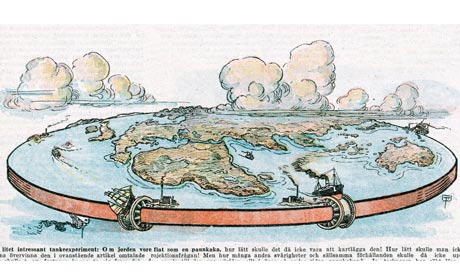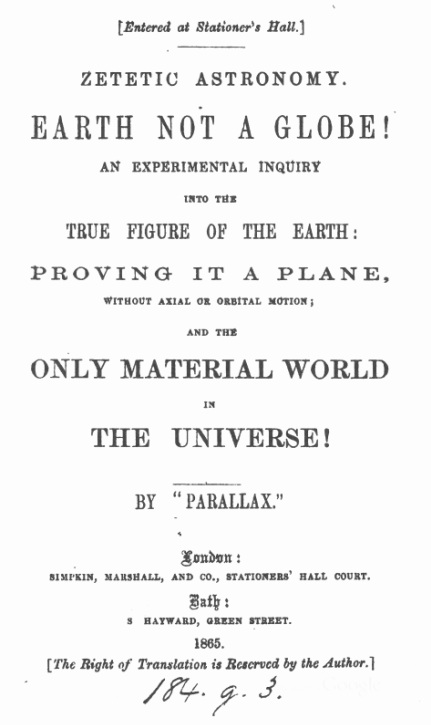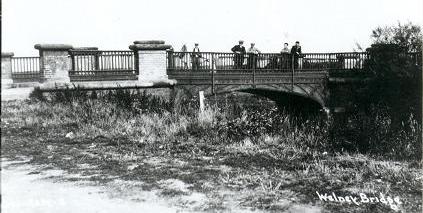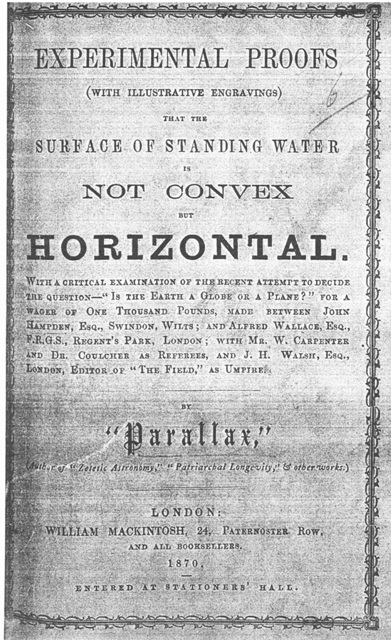- Contents of this page
Introduction
This page has nothing to do with the operation of the Ouse Washes, but it does show one of the most unusual uses made of the Old Bedford River.For thousands of years people assumed that the Earth was flat. Indeed, why would they have thought otherwise? But the idea lived on in the minds of some well beyond a time when most realised or accepted that it wasn't.
|
page last updated 05 November 2015 |
| If visted before, please "refresh" page to see latest version. |
wall of ice on the southern edge. (Maybe it would have been more logical to claim the wall encircled the whole disc to prevent the oceans and sea
draining off.) And so it was that the "Flat Earth Society" was formed.

Chronology
| year | experiments by | reference | looking from | to |
| winter 1837 | Samuel Rowbotham | observations made on frozen river | ||
| summer 1838 | Samuel Rowbotham | first experiment to show Earth is flat | Welches Dam | Welney Bridge |
| 1844 | Samuel Rowbotham | more experiments to show Earth is flat | ||
| 1849 | Samuel Rowbotham | more experiments to show Earth is flat | ||
| 1856 | Samuel Rowbotham | more experiments to show Earth is flat | ||
| 1862 | Samuel Rowbotham | more experiments to show Earth is flat | ||
| 1870 | Alfred Russell Wallace | experiment to prove the Earth is a globe | ||
| April 1870 | Samuel Rowbotham | more experiments to show Earth is flat | Welney Bridge | Old Bedford Sluice Bridge (Salters Lode) |
| 1901 | H. Yule Oldham | |||
| 1904 | Lady Blount | used photography to show Earth is flat | Welney | |

In an 1865 publication (see left) he states that his 1838 experiment was on a six mile stretch from Welney Bridge looking towards Welches's Dam, whereas in the 1881 edition of his book "Zetectic Astronomy: Earth Not a Globe" he says it was the other way round. The latter is supported by other remarks in the book, e.g. when describing an incident when he was asked to look in the 'opposite direction' (presumably looking south from Welches Dam) and witnessed the apparent 'disappearance' of a vessel, which then reappeared a short time later. It seems the boat was simply out of sight while negotiating a small kink in the otherwise straight waterway. There is just such a kink at 'The Gullet' south of Sutton Gault.
When describing his fifth and last experiment in 1870, it seems he used a different part of the River because he says he made his observations from a sluice bridge two miles from Downham Market railway station (which he had arrived at from London) and he describes barges entering the canal from the River Ouse bound for Ramsey (which was accessible by boat via the 40 foot River from Welches Dam). He must therefore have been looking from Salter's Lode (a hamlet to the east of Nordelph) towards Welney, which is also a distance of six miles.
The following article was written by the Webmaster of the Nordelph Website for posting on both the Nordelph and Welney websites and is shown here by kind permission of both webmasters.
back to contents
The Bedford Level Experiments
I am indebted to John Jaworski for allowing me to post the following article written for the Nordelph and Welney community websites"The issue was the relatively straightforward one of whether the Earth was flat (as the Zetetics held) or round (the Globularists). It's tempting from the comfort of a 21st century scientific perspective to laugh at the Zetetics, but we should perhaps be inclined to a little humility. The Zetetic philosophy was essentially one of 'proceeding by inquiry', which meant that any proof that the Earth was round would have to be the result of an experiment, not simply calculation. The world looks flat (just as the sun seems to orbit the earth) so it should be presumed flat unless it could be demonstrated otherwise.
| Another "experiment" in 1838, but of a very different sort, was the Colony at Manea, a socialist commune built alongside the west bank of the Old Bedford River a couple of miles south of Welney, where Samuel Rowbotham was Secretary for a while, and lived there for 2 weeks |
The first attempt at an experiment was in 1838, when one Samuel Birley Rowbotham ('Parallax') made observations along the Old Bedford Level, one of Vermuyden's finest drainage constructions and which, from Welney, runs dead straight for six miles. Rowbotham was a convinced flat-earthist, which may have influenced his observational technique.
But nevertheless, from Welney Bridge he clearly saw (through a telescope) barges on the river some six miles distant. In fact, because of the curvature of the earth, from ground level looking over a flat surface, you can see no more than three miles -- his barges should have been well below the horizon. The Zetetics concluded erroneously that the earth was flat, and everything went quiet until 1870.

The cast iron bridge that used to span the Old Bedford River at Welney was built some time between 1820 and 1850.
There were doubtless many scientists around who could have pointed out that Rowbotham's results are comfortably explained by the refraction of light close to a warm surface, the basis of many desert mirages.Note: John Harvey emailed in July 2018 saying that reference above to a warm surface is incorrect, and the explanation should read "by the refraction of light close to a cool surface (the water) which causes the light to be refracted downwards". John also gave a detailed explanation of this for which I'm grateful and which I'll make available later.But no one seemed to have the stomach for more experimenting until Alfred Russel Wallace, noted for espousing the new theory of evolution and hence used to the impolite cut and thrust involved, set up a rather more elaborate experiment. In part, this was because one John Hampden of Swindon had underwritten a wager of some £500 that a new experiment would establish the flatness of the earth for all time.
Three barges were used, on each of which was erected a straight rod, all the same height. The barges were moored two miles from each other along the same stretch of water. The tops of the rods were thus all the same distance above the surface of the earth. Using a theodolite, Wallace sighted from the top of the first rod to the top of the third. If the earth was flat, the top of the middle rod would lie on the same line.

cover of Rowbotham's 1870 book refers to a wager of £1,000

In fact, because the earth was curved, the third rod was lower than the second: the second marker was a clear 32 inches above the line from the first to the third (sometimes reported to be five feet -- doubtless to emphasise the clear victory for the Globularists). This makes the diameter of the earth 7920 miles -- pretty good for 1870, as we now believe that the earth's equatorial diameter is 7926 miles (the earth isn't a perfect sphere, and has different diameters at different places).
Unfortunately for Wallace, but fortunately for those of us who are enjoying the story, the Zetetics (also known as the 'planists', by the way) looked at the same results and somehow managed to convince themselves that a trick of perspective was involved and that this did, after all, prove that the earth was flat! John Hampden refused to pay up, and the matter went to court some six years later. In a wonderful instance of jurisprudential cunning, the presiding judge declined to rule on what might be deduced from the experiments and contented himself with adjudging that such wagers were not legally binding! Hampden responded badly to a verdict that had, after all, saved him £500. He became obsessed and conducted a campaign of vilification against Wallace for the rest of his life, which led to several prosecutions for libel and accompanying prison sentences.
As so often happens when people disagree, neither side ever managed to convince the other -- indeed, the Flat Earth Society continued in being until the 1980's. What happened thereafter was that newcomers simply repeated the experiment associated with what they wanted to prove. In 1901, H. Yule Oldham repeated the Wallace experiment pretty exactly and got the same result, which he reported to the British Association for the Advancement of Science. In 1904, a Lady Blount repeated essentially the Rowbotham experiment with the added value of new-fangled photography: at least her result was demonstrable, and didn't rely on hearsay. This time, she photographed a white sheet hanging two feet above the water, six miles away -- just as Rowbotham had (and for the same reasons) she could see the theoretically hidden bottom of the sheet, and what's more its reflection in the water!
We may laugh now, but it is hard to disbelieve the evidence of our eyes, and the Zetetics were not fools. One modern analogy might provoke some reflection. The Bedford Level experimenters used the river because it was flat and straight. As with us, they looked around and saw jagged mountains, ocean trenches and very little flatness -- the river was a godsend. But in fact, considering the scale, compared to a billiard ball the earth is several orders of magnitude smoother on its surface!"back to contents
- related pages on this site
- related external websites/pages
Appendix
An intriguing adition to this tale is recorded on the Welney Website. Apparently the Flat Earth Society was 'resurrected' in 2004, and in November 2009 the President of the Society, Daniel Shenton, wrote to Welney Parish Council requesting permission to display a plaque on the Bedford Bridge commemorating the 1838 experiment. The matter was discussed at the Council's meeting in December 2009 and it was suggested he should contact Norfolk County Council. At the same meeting a letter from Russell Duffy regarding Mr Shenton's request was discussed but no details are shown in the minutes.I don't know the County Council's response, but as at June 2013 no plaque has been erected, which I find sad as Welney needs more "touristy" attractions.
Learn more of the Flat Earth Society at their own new website (link on left).
|
Acknowledgements. Text and photos except where noted © Eddy Edwards, 2010-12 With thanks to the webmasters of the community websites for Nordelph and Welney. If you think there are any errors or omissions on this page or would like to comment, please e-mail me and your response will be noted where appropriate. |